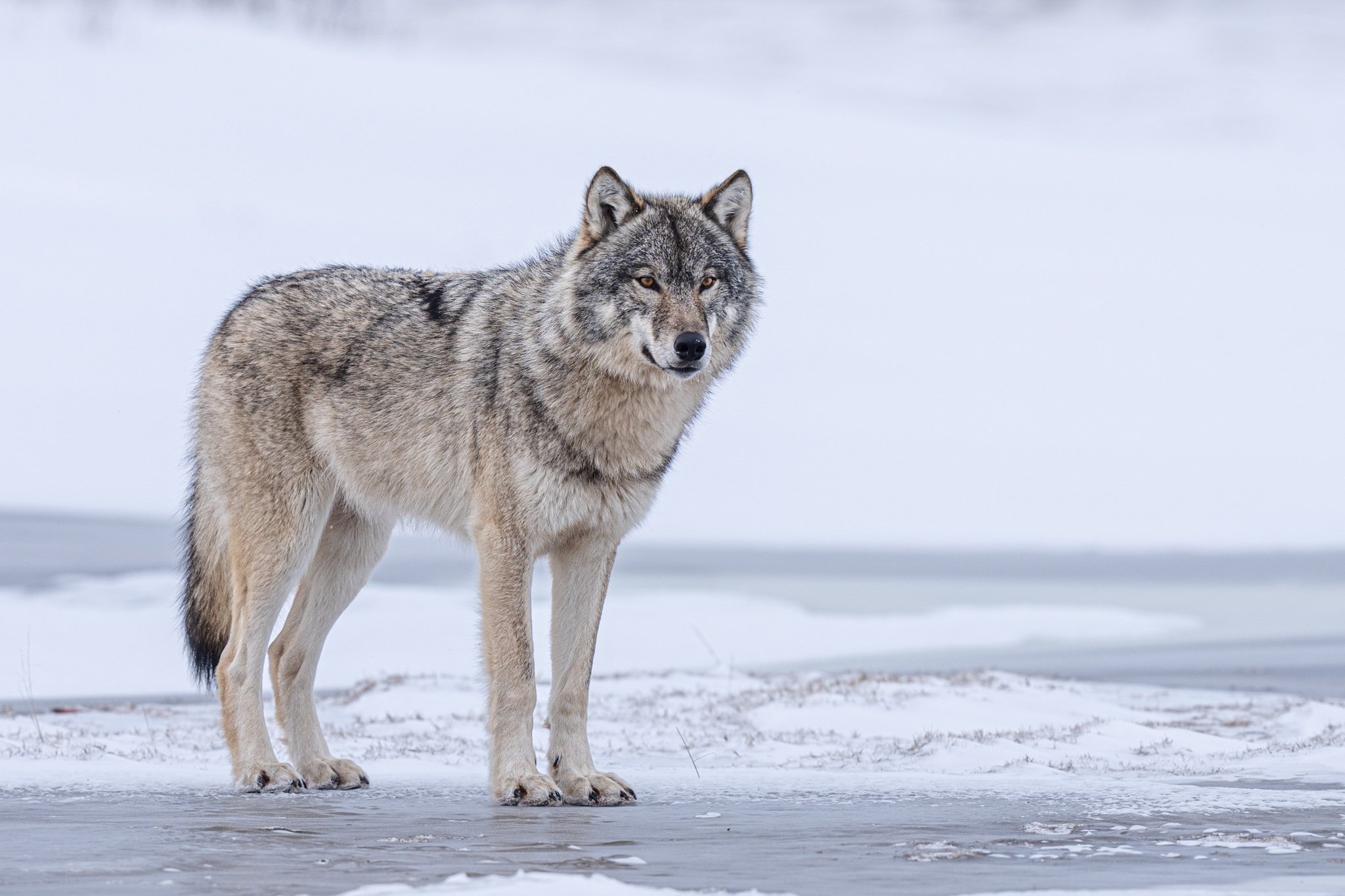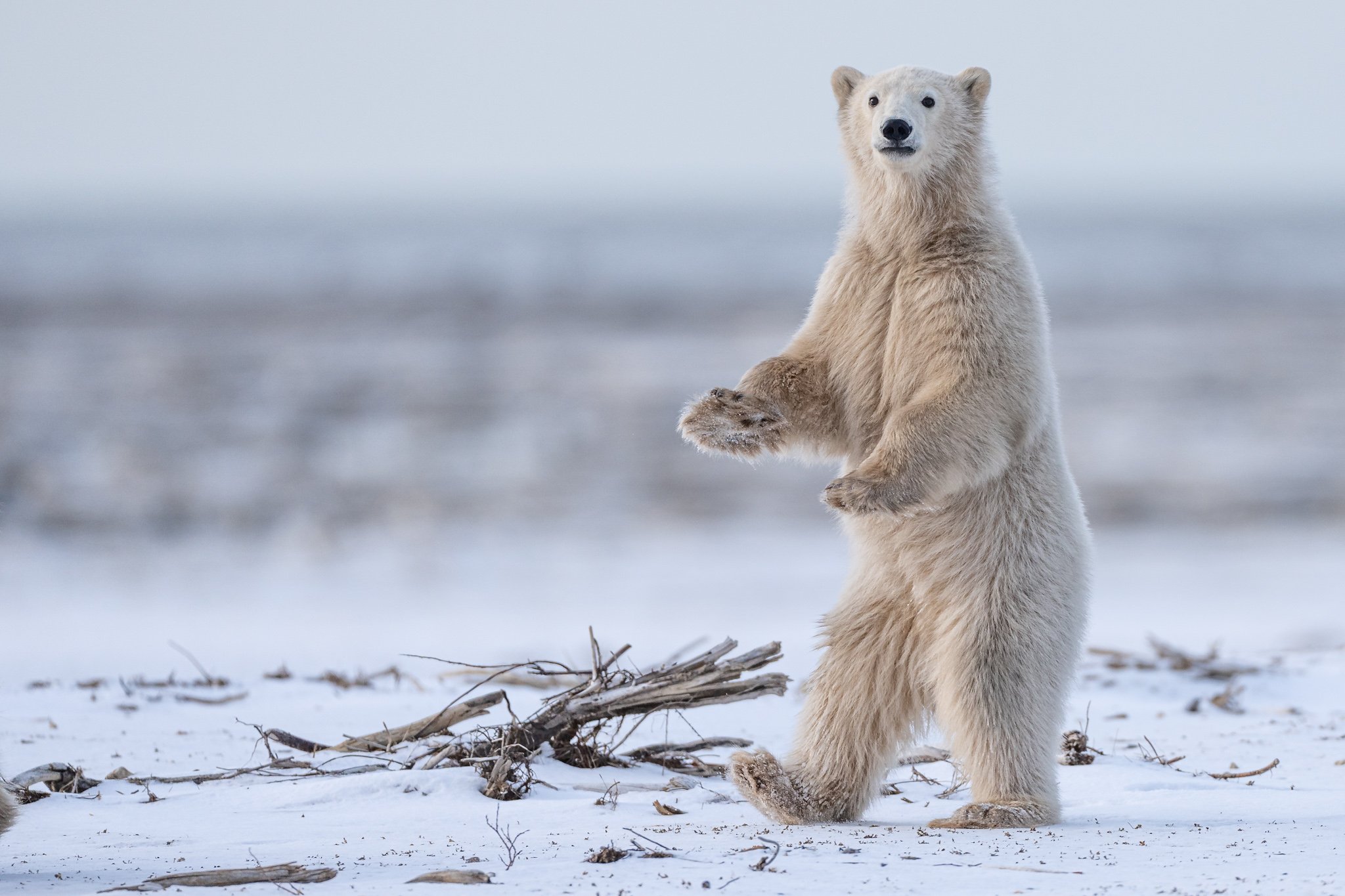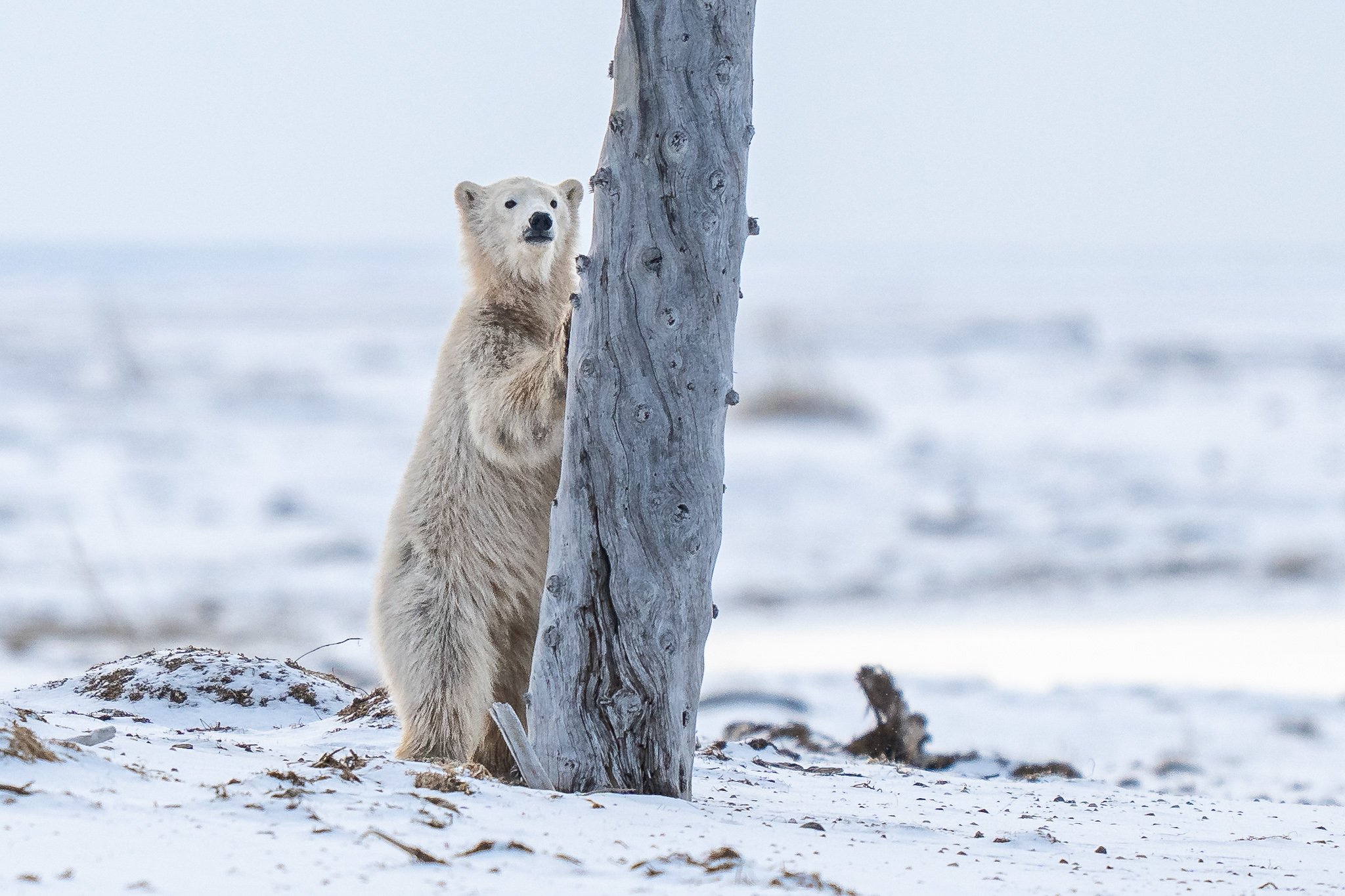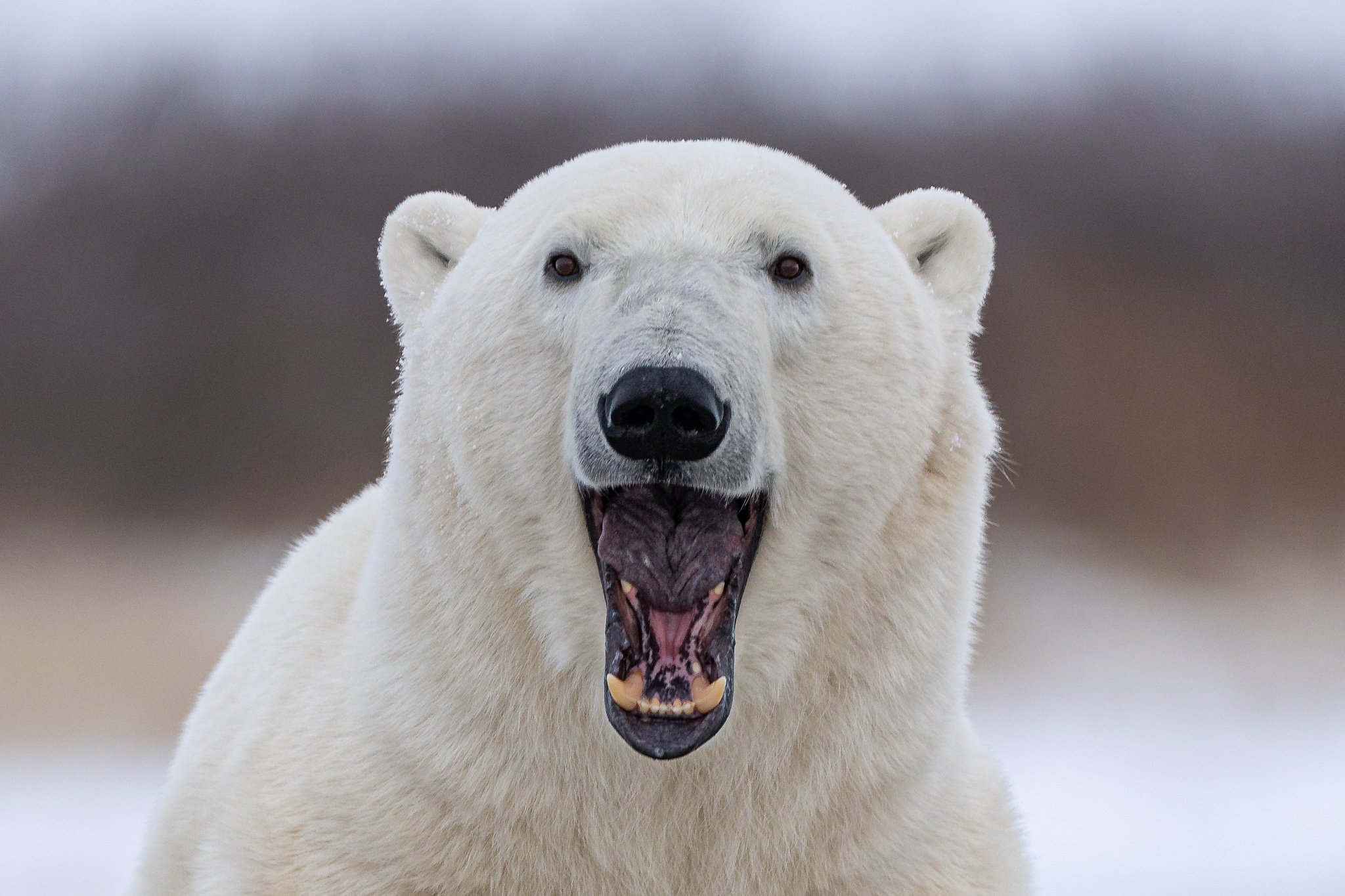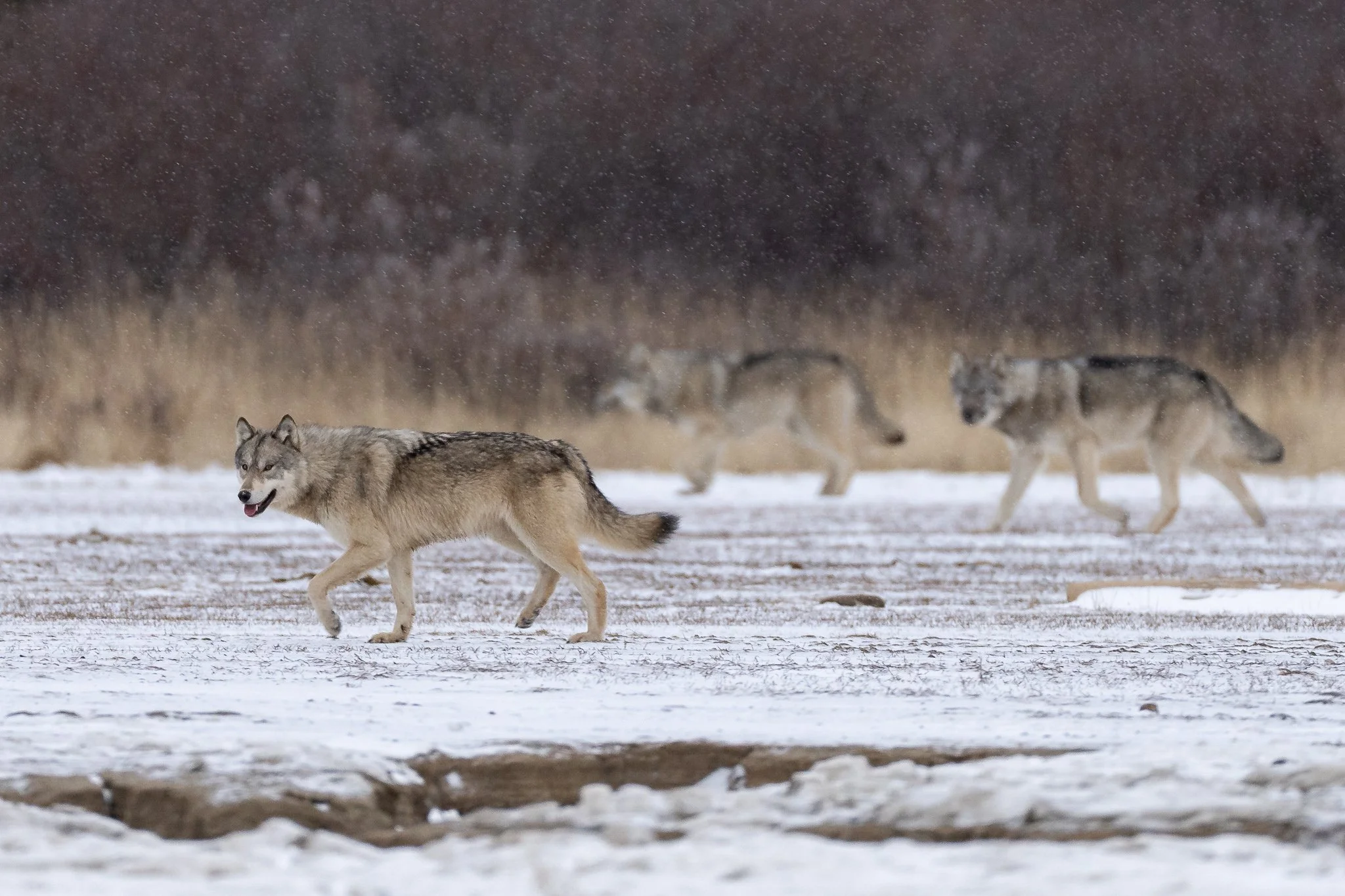The Big Freeze 2021
In November, temperatures are usually dropping rapidly in northern Manitoba. As soon as the shallow waters of Hudson Bay start freezing over, the local polar bears are heading out on the sea ice, their favorite hunting grounds. But this year was different. We arrived at Nanuk Polar Bear Lodge in early November and there was no snow or ice yet. During our three week stay at the lodge, we could see and feel the Arctic winter approaching. When we left at the end of November, everything was deep frozen with temperatures below -20°C (-4°F). Experiencing the change of seasons was very special.
Getting There
November temperatures on the coast of Hudson Bay usually range from -10°C (14°F) to -30°C (-22°F). Despite the warmer than usual temperatures recently, we decided to bring our warmest winter gear. Temperatures can drop rapidly in this area and there‘s nothing worse than not being able to enjoy the trip because you’re feeling cold. Packing for three weeks and still staying within the 22kg weight limit is quite a challenge. In the end, we almost succeeded…
Still being in the middle of the COVID pandemic meant that we had to have a negative PCR test before our departure despite being vaccinated. Canada has always been cautious around COVID, which might not have been appreciated by the tourism industry, but made us feel safe traveling there. We flew from Zurich to Toronto and on to Winnipeg. We stayed there for two days. On the second day, we were fitting our rental winter gear. We always bring our own boots, but for the ski pants and parkas, we rely on tour operator Churchill Wild. Their FXR pants and Quartz parkas are just a lot warmer than anything you could buy in Europe.
So, we made our way to Winnipeg airport already dressed for the Arctic. While we would not have needed our full gear for the charter flight to Churchill, it is mandatory to wear winter gear on the flight to Nanuk Polar Bear Lodge in a small Cessna Caravan. In the unlikely event of an emergency landing, you wouldn’t want to be searching for your jacket in the usually freezing conditions.
This time, however, we wouldn’t even have needed our warm gear on this last flight leg. While there was some snow in Churchill, there wasn‘t any further south, around York Factory and the lodge. We didn’t mind since it was a sunny day and we already spotted plenty of wildlife from above. Arriving at the lodge felt like coming home. In the past, we had spend a total of roughly three weeks at Nanuk, with three more just ahead of us.
Polar Bears
Nanuk Polar Bear Lodge sits on a small island of the Opoyastin Creek, right on the shores of Hudson Bay. While the high tide line is close to the lodge, on low tide there are several kilometers of muddy coastal flats between the lodge and the open bay. But even at that distance, you can still hear the waves crashing on the beach. Well, usually in November, you wouldn’t be hearing the waves anymore. Everything should be frozen solid and the polar bears should be able to make their way out onto the sea ice. But with temperatures well above freezing, there was no ice, yet. This meant, that all polar bears were still stuck on shore. This allowed for some of the most exciting polar bear encounters we have ever experienced. At first, we were afraid, that the late freeze could be a problem for the starving polar bears. But the sea ice lasted almost four weeks longer than usual last summer. Therefore, the bears were still well fed and healthy looking.
On many mornings, we had to delay our departure from the lodge as a polar bear was roaming just outside the fenced compound. So why should we leave the lodge if the most exciting wildlife action happened just at our front door? Several bears stayed around the lodge for a few days before eventually heading off. Our most loyal bear was probably Brutus, as he has been named by the staff. We sometimes encountered him out on the coastal flats, but most of the time, he came right to the fence. Even on our departure day at the end of November, Brutus was sitting on the runway. We know, you shouldn’t anthropomorphize animals. But Brutus seemed to be genuinely sad that we were leaving. We still don‘t know if he considered us his entertainment or a possible food source. But you could see, that he was sorry to see us leaving (and so were we).
One day, two large male polar bears were play fighting just outside the lodge on the runway. Polar bears are solitary animals for most of the year. But when they are stranded without any proper meal (seals) in sight, they are getting along surprisingly well. With „getting along well“ being relative: Even play fighting looks quite dangerous when polar bears are involved. Especially cute and fun encounters are moms and cubs. While mom is usually cautious, the cubs are more curious. We almost felt sorry for a mom with two cubs. One was especially bold, sniffing around, walking on his hind legs, trying to push over a wooden pole etc. He was even unimpressed when mom grabbed him by the neck to (try to) teach him a lesson.
Another day, there were five adult polar bears out on the slowly forming sea ice. With so many polar bears in the area, it was very reassuring to have our knowledgeable guides with us. Tour operator Churchill Wild has developed a unique way of encountering polar bears: on foot, on the ground. What may sound like a suicide mission, is in fact one of the most emotionally touching and special ways of seeing wildlife. They have been successfully doing and refining this for over 25 years, without any incidents. Probably the most important part of this is trying to read and understand polar bear behavior. Our experienced guides could easily tell if a polar bear was curious, bored, aggressive or playful. As important as reading the polar bears is acting accordingly. An aggressive or too curious animal would be pushed away with shouting, clicking of rocks or throwing a rock at it. The guides are equipped with a starter pistol (as a noise deterrent) and are also armed with a shotgun. The latter had never needed to be used, but it would simply be irresponsible to be in polar bear territory unarmed. However, the guides are very clear: A successful polar bear encounter is one, where we approach the bear, watch it and retreat without scaring it away. We would never go closer than 100 meters, but if a bear is not aggressive and decides to get closer, the guides would usually allow this. Our closest bear encounter was probably 15-20 meters.
Wolves
Polar bears are not the only apex predators in the area. There is a pack of 10-15 wolves roaming the Kaska Coast between the Hayes River and Cape Tatnam. Since these wolves have never been studied, not much is known about them. We have had great wolf encounters on all our trips to this area. That‘s why Churchill Wild decided to offer trips with more focus on wolves than polar bears. The idea for these trips was developed by our friend, NatGeo photographer Jad Davenport. We might even have been a small part of this idea, due our incredible wolf encounters in March 2019. Now, we were excited to participate in the two inaugural wolf trips. These trips are not just about watching and photographing wolves. Rather, they are part of a citizen science project with the goal of getting to know more about these wolves. Are they related to other wolf populations in North America, or are they a seperate subspecies? What do they feed on? How big is their territory? etc.
Since these wolves have never been hunted and are living in one of the most remote areas imaginable, they are still truly wild. This provides a unique opportunity for viewing and researching wild wolves without interfering with them. We had many incredible encounters during this trip. Sometimes, we saw the entire pack, sometimes just one animal. An especially beautiful encounter was, when we were heading west with the ATVs. Just before we crossed the Opoyastin Creek, a single wolf stepped out of the willows onto our trail. We believe, he was the breeding male, also known as alpha wolf. He looked at us for a while and disappeared into the bushes as quickly as he appeared.
One day, two wolves approached a polar bear who was resting close to the lodge. They were sneaking up on him, trying to nip his butt. Wolves would not try to hunt adult polar bears and a polar bear would not be able to catch a healthy wolf. The wolves were probably harassing the polar bear just because they can. Eventually, the polar bear hissed at the wolves who then retreated. What an amazing interaction.
When we were not actively watching wolves, we were experimenting with a lot of technical gear: we configured trail cams (for capturing wolf and other wildlife footage), we tested our directional microphones (for recording the howling), set up a photo printer (for later identifying individual animals by their markings) and listened to interesting presentations on wolves. And we even collected wolf scat (poop) outside the lodge for DNA analysis. The inaugural wolf trips were a huge success and we can‘t wait to get back to Nanuk for following up on these initial activities.
But There‘s More…
Polar bears and wolves are usually getting the entire attention. But there are many more fascinating animals up North. We have spotted red foxes, a cross fox and even an Arctic fox. Further north, Arctic foxes are quite common. But as far south as the Kaska Coast, there are very few Arctic foxes. We know that the much bigger red foxes sometimes predate on Arctic foxes. We were therefore really surprised, when we saw an Arctic fox and a red fox walking side by side. They seemed to be best buddies.
On a windy day, we spotted a snowy owl sitting in the willows. She was probably scanning the fresh snow for her favorite food: lemmings. Being able to fly completely silently, a lemming would probably not even know what got him. Poor lemmings!
One of the most amazing things are Arctic sunrises and sunsets. Even on an overcast day, there is sometimes just enough open sky at the horizon to allow for some golden rays of sunshine. The golden light then illuminates the cloud cover from underneath, creating some of the most spectacular sunrises and sunsets we have ever seen.
And don‘t forget about the northern lights. With quite a few cloudy nights, we didn‘t see the aurora borealis on very many nights. But on clear nights, we had some wonderful displays. Watching the aurora dancing across the sky is always magical.
The Lodge
This was our third time at Nanuk Polar Bear Lodge. In addition, we have been staying at Seal River Heritage Lodge, also owned by Churchill Wild, twice. We love to stay at the lodges of Churchill Wild, because of the unique experience they are providing. Their staff is great and the lodges are very cozy and luxurious, especially taking into account their remote location. You get electricity 24/7, hot showers and even Internet connectivity. That‘s pretty amazing for a lodge that is completely off grid, about 200 kilometers from the closest permanent settlement. Food is also great: We managed to put on weight on all of our trips…
Nanuk Polar Bear Lodge has eight guest rooms, therefore accommodating 16 guests max. That’s a good group size for watching wildlife. We always enjoy the company of our fellow guests. Everyone traveling to such a remote place shares a love for wildlife and natural beauty. That‘s a lot of common interests among the guests, which is always a good starting point for fun and interesting talks.
Weather
As already mentioned, fall was much too warm in northern Manitoba. This provided the unique opportunity for us to experience the change of seasons from fall to winter. Temperatures dropped by more than 30°C (54°F) during our three week stay. And while we could initially hear the waves crashing on the beach a few kilometers away from the lodge, one morning, this sound was suddenly gone. We quickly realized that sea ice had formed and therefore muted the constant wave action.
Nanuk Polar Bear Lodge is situated on a small island between to arms of the Opoyastin Creek. During the first few days, we could still cross the Opoyastin with the ATV, since there was no ice. But then, colder nights brought a thin layer of ice. This new ice was too thin do drive or walk on, but too thick to just crash through it with the ATVs. We were therefore stuck on „Nanuk Island“ for a few days. We didn‘t mind, though, because we had plenty of wildlife just around the lodge, within easy walking distance.
Eventually, the ice on the creeks grew strong enough and a two day blizzard brought enough snow, that we could switch from the ATVs to the snowmobiles. The ATVs have been pulling wheeled trailers. Now, the Ski-Doos pulled traditional Inuit sleds, so called komatiks. The well suspended trailers were probably a smoother ride, but traveling with snowmachines and komatiks was definitely more fun. And it allowed us to cover more ground, since we were not confined to the trails anymore but could also use the coastal flats.
November is also the time of weather delays in air traffic. The three weeks we were staying at the lodge were sold as four separate trips. On two of the three changeover days, weather conditions didn‘t allow for flying from Churchill to Nanuk. For the departing guests, this meant an additional night or two at the lodge. The incoming guests had to wait in Churchill until the weather improved. But everyone was well taken care of and safely arrived at the lodge or at home.
Experiencing the big freeze from fall-like conditions to temperatures around -40°C (-40°F) with wind chill, was fascinating. As soon as the temperatures dropped, the polar bears got more active and started pushing towards the shoreline. However, not all polar bears are heading out onto the sea ice. Pregnant female bears are heading inland to their denning sites, where they will give birth to their cubs in late December or early January. These moms and cubs will then be making their most challenging journey from their dens to the sea ice of Hudson Bay in March. We have participated in the Den Emergence Quest already once, in 2019. Now, we will be back in February and March 2022 to search for moms and cubs. Stay tuned.





